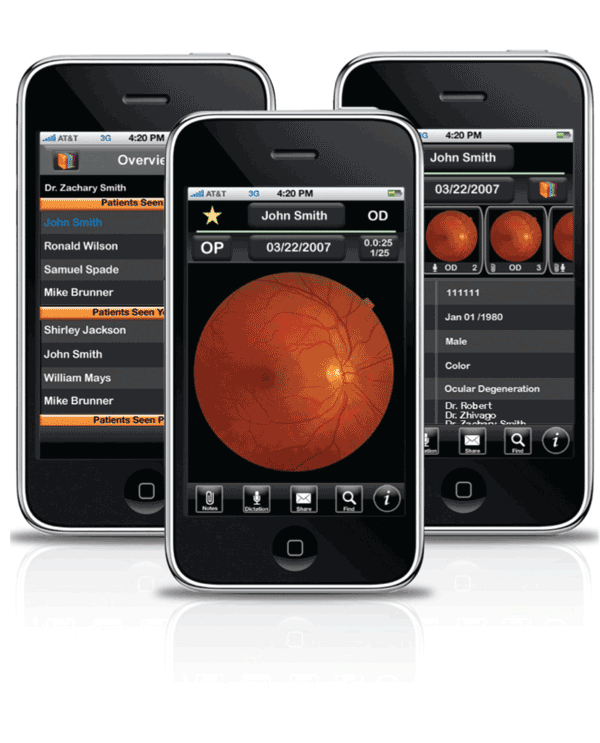Canon
The Canon CX-1 allows the user to take one-shot fundus autofluorescence photographs in a standard configuration, for both mydriatic and non-mydriatic modes. FAF is the occurrence of autofluorescence in macular waste, particularly lipofuscin. Examinations that check and monitor autofluorescent waste material are a key step in age-related muscular degeneration detection. Canon says using the non-mydriatic mode not only saves time and resources, it also can make the diagnostic procedure more comfortable for the patient.
The company says the CX-1 is capable of delivering clear and detailed diagnostic images for virtually immediate review. The single onboard digital camera handles five different photography modes, including non-mydriatic FAF, color, red-free, cobalt and fluorescein angiography photography.
The Retinal Imaging Control Software that comes with the CX-1 puts tools for comprehensive study management, image-capture controls and easy viewing at the user's fingertips. The intuitive graphical interface is simple and straightforward to use. The PC-based software provides quick input and access to information and images required to assist in patient diagnosis, and data can be easily saved to various external media.
For information, visit usa.canon.com/eye care.
iPhone App Available for EyeRoute
Topcon now offers a mobile version of its EyeRoute Image Management Suite as a dedicated iPhone application from the Apple iTunes store in
Ophthalmologists who have incorporated EyeRoute in their practice can now securely access images and reports from any 3GS-compatible iPhone, iPod touch or iPad via EyeRoute Mobile, even when out of the clinic, from anywhere Internet connectivity is available.
Using the EyeRoute Mobile's intuitive touch screen, patient images stored in EyeRoute can be listed by modality or visit date, and reviewed, panned, zoomed, enhanced and annotated with text and audio dictation options. Once reviewed, a smart integrated messaging system allows users to share information with other EyeRoute users through the network.

The EyeRoute Mobile application can be downloaded from the Apple iTunes store, at an early adopter price of $19.99 for the first year. Even users who currently do not use EyeRoute in their practice may gain access to an extensive demo database of images and pathologies and the various viewing and editing features. Customers who use EyeRoute in their practice can then activate the link to the mobile application and gain access to their own EyeRoute database. A 3GS-compatible iPhone, iPod touch or iPad with OS 3.0 provides optimal performance and is recommended for integration with EyeRoute Mobile.
The EyeRoute Ophthalmic Image Management System integrates images and reports from Topcon and more than 100 other manufacturers' systems into a single, secure, digital environment with the ability to view, compare, annotate and transmit patient images. Designed as a scalable and flexible solution, EyeRoute integrates with most EMRs, is fully standards compliant (DICOM, HL7) and scalable. For information, visit topcon.com.
Pearls from the Deep
P. Dee G. Stephenson, MD, FACS, ABES, FSEE
Seeing
How good are my cataract surgery refractive outcomes? I find myself asking that question a lot more lately. What was once considered to be an acceptable outcome may not be acceptable any longer when using premium lenses. Patients are paying premium dollars and want premium outcomes.
It is very common to hear my colleagues say that they get within 0.5 D of their target in about 80 percent or more of their patients. But, more and more in the literature there is convincing evidence that it may be less than 65 percent for most surgeons, and in post-LASIK and post-RK patients it has been reported to be less than 50 percent.
We have all these new formulas and machines like the IOLMaster to calculate the IOL power in cataract, post-LASIK, post-RK and high-astigmatism patients, but all of this is lost unless we do the most important thing; that is, each of us needs to perfect our own technique, A scan, capsulotomy and surgeon factor, know our surgically induced astigmatism, enter our results in a data bank and have consistent, predictable reproducible outcomes that allow fewer variables, and that allow us to strive to make our results better and our patients happier.
For the last year I have been concentrating heavily on my own surgical technique and the things that go with that. I have also been using The ORange Intraoperative Wavefront Aberrometer (WaveTec Vision Systems). This is a huge leap in my practice to optimize surgical decision making in the OR, and in striving to make my outcomes as optimal as possible. This, in turn, makes for happy patients. Prior to
There are an estimated 14 million post-LASIK patients out there who someday will need cataract surgery. Every year this will increase. We as cataract surgeons need to be able to deliver excellent results. That being said, why not utilize this great technology? WaveTec is constantly trying to improve its outcomes by analyzing current users results. Not only have I improved my cataract outcomes, I have improved both my post-LASIK and toric outcomes as well. With every upgrade I have been able to refine them even more. Most important, my patients are happier.
Dr. Stephenson has no financial interest in the product or the company.



